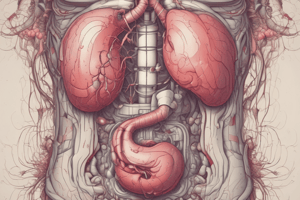Podcast
Questions and Answers
What does UGIT bleeding refer to?
What does UGIT bleeding refer to?
- Bleeding from the colon
- Bleeding proximal to the ligament of Treitz (correct)
- Bleeding from the rectum
- Bleeding distal to the duodenum
Which of the following is NOT a common cause of UGIT bleeding?
Which of the following is NOT a common cause of UGIT bleeding?
- Esophageal varices
- Diverticulosis (correct)
- Gastric peptic ulcer disease
- Erosive gastritis
What symptom involves vomiting blood?
What symptom involves vomiting blood?
- Duodenitis
- Hematemesis (correct)
- Melena
- Hematochezia
Which of the following is a characteristic of melena?
Which of the following is a characteristic of melena?
Which condition is a cause of duodenal bleeding?
Which condition is a cause of duodenal bleeding?
What percentage of patients with peptic ulcer disease bleeding stops without intervention?
What percentage of patients with peptic ulcer disease bleeding stops without intervention?
What is a clinical symptom of mild bleeding in peptic ulcer disease?
What is a clinical symptom of mild bleeding in peptic ulcer disease?
Which management step should be performed first after a patient presents with peptic ulcer disease bleeding?
Which management step should be performed first after a patient presents with peptic ulcer disease bleeding?
Which medication is used as a chemical measure in managing peptic ulcer disease bleeding?
Which medication is used as a chemical measure in managing peptic ulcer disease bleeding?
What should be monitored carefully during the management of peptic ulcer disease bleeding?
What should be monitored carefully during the management of peptic ulcer disease bleeding?
Study Notes
Upper Gastrointestinal Tract (UGIT) Bleeding Overview
- UGIT bleeding refers to gastrointestinal bleeding occurring proximal to the ligament of Treitz, affecting the esophagus, stomach, and duodenum.
Causes of UGIT Bleeding
Esophageal Causes
- Reflux esophagitis
- Esophageal varices
- Mallory Weiss tear
- Esophageal carcinoma
Gastric Causes
- Erosive gastritis
- Gastric varices
- Portal hypertension gastropathy
- Peptic ulcer disease (PUD)
- Gastric tumors (including carcinoma and gastrointestinal stromal tumors)
Duodenal Causes
- Duodenitis
- Duodenal diverticulitis
- Duodenal peptic ulcer disease
- Duodenal carcinoma
Clinical Presentation
- Hematemesis: Vomiting blood, categorized by severity:
- Mild to massive, can indicate shock or chronic anemia.
- Hematochezia: Fresh blood per rectum indicating massive bleeding, with categorized severity affecting hypovolemia.
- Melena: Dark, tarry stool suggesting upper GI bleeding.
Symptoms of UGIT Bleeding
- Hematemesis
- Coffee ground vomit
- Melena
- Hematochezia
Peptic Ulcer Disease (PUD) and Bleeding
- 80% of PUD cases resolve without intervention.
- Common symptoms range from asymptomatic to massive hemorrhaging.
- Diagnosis involves epigastric tenderness and endoscopy for location confirmation.
Management of UGIT Bleeding
- Keep the patient NPO (nothing by mouth) until endoscopy.
- Insert a nasogastric tube and perform cold saline lavage.
- Establish two peripheral lines and obtain blood samples for cross-matching.
- Administer fluid replacement and blood transfusion as needed.
- Close monitoring of vital signs and urine output to manage complications.
- Use of chemical measures, such as PPI and vasopressin, to prevent bleeding recurrence.
Endoscopic Procedures
- Diagnostic and therapeutic to control bleeding and assess rebleeding risk.
- Forrest Classification identifies ulcer rebleeding risk:
- Forrest Ia: High risk (arterial spurting)
- Forrest Ib: Moderate risk (oozing)
- Forrest IIa: High risk (visible vessel)
- Forrest IIb: Moderate risk (adherent clot)
- Forrest IIc: Low risk (black spots)
- Forrest III: Low risk (clean ulcer base)
Intervention Techniques
- Heat Probe (Diathermy): Utilized for coagulating blood vessels.
- Laser Photocoagulation: Non-invasive method using light to induce coagulation.
- Injection Treatments: Adrenaline and thrombin to facilitate clotting.
- Mechanical Methods: Clips and sutures for hemostasis.
Surgical Interventions Indications
- Required for massive bleeding (>10 units), treatment failure, or complications like perforation.
- Age over 45 years or visible bleeding vessel increase rebleeding risk.
Rebleeding Insights
- Occurs in 5% of cases, most frequently within the first two days post-initial episode.
- Mortality rate increases significantly to 25% upon rebleeding.
Summary of Key Diagnostic and Risk Signs
- Endoscopic findings such as visible vessels or spurting indicate higher rebleeding risks.
- Diagnostic emphasis on identifying ulcers near critical vasculature to mitigate severe outcomes.
Studying That Suits You
Use AI to generate personalized quizzes and flashcards to suit your learning preferences.
Description
Test your knowledge on upper gastrointestinal tract (UGIT) bleeding causes and definitions. This quiz covers essential conditions such as esophageal varices, erosive gastritis, and various tumors. Prepare to enhance your understanding of UGIT bleeding.



